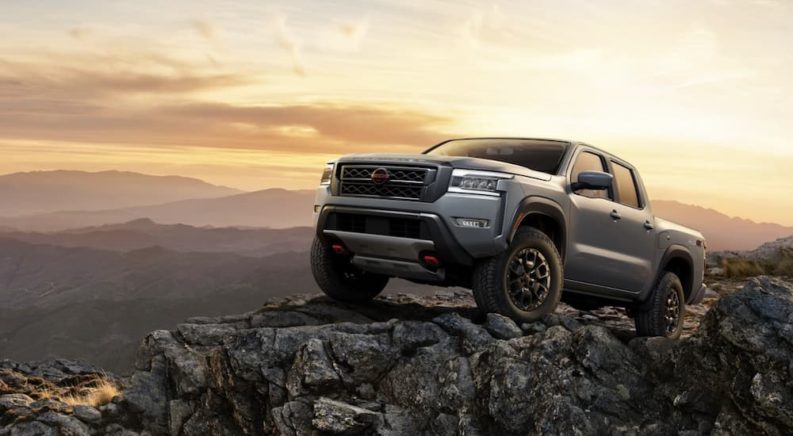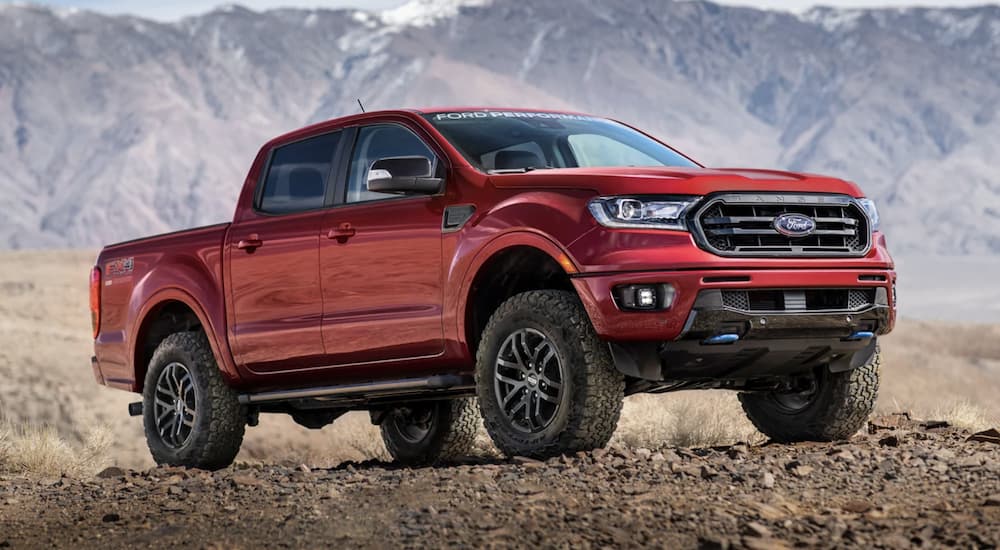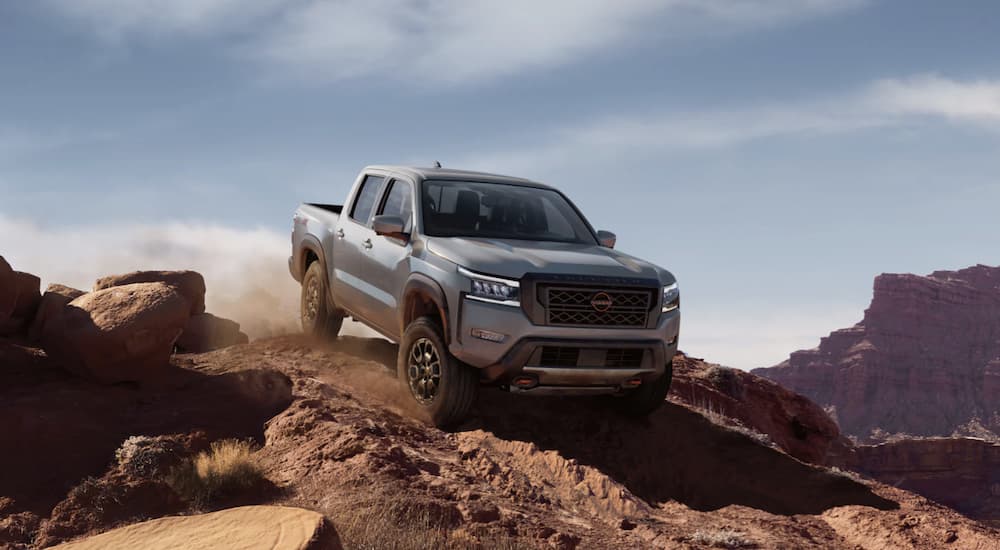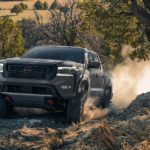A game of tag is afoot in the burgeoning midsize pickup category, and Ford is it. Nissan’s recent release of the redesigned Frontier puts Ford on the hot seat to deliver on its next-generation Ranger, but does it have the goods? The 2022 Nissan Frontier vs 2022 Ford Ranger presents a gripping plot line for exploring generational lifecycles and how they impact owner satisfaction.
Truck fans are keenly aware of the growing consumer interest in pickup trucks. Insiders argue it stems from SUV fatigue, and they’d be half-right, but something else is at play. Off-roaders in the family way are tired of unibody crossovers that dampen trail riding enjoyment. Sure it’s a vanilla styling issue, but the problem is far more complex than just aesthetics.
Ford relaunched an all-new Ranger pickup in 2019 to lukewarm reviews. J.D. Power called it “inoffensively styled,” and the results were equally flat of the newly restyled truck’s performance with reports of an “unrefined” drivetrain. Most notably, the reviewer stated that “Ford needs to address the Ranger’s suspension tuning,” calling the ride “too soft.” This goes right to the heart of the matter: shouldn’t a pickup truck drive like a pickup truck?
Redesign Miscues: The Ranger’s Woes
It says something that Ford went back to the drawing board so soon after launching an all-new Ranger. For 2023, it’s expected the Blue Oval will make some serious corrections. Unfortunately, that leaves the 2022 version for current buyers to ponder. It begs the question–did Ford rush the process in a money-and-market share grab, and will loyal Ford buyers wait for the upgraded version?
The 6th place 2022 Ford Ranger, as rated by MotorTrend, confounds with its respectable capabilities and oxymoronic spongy ride handling. Not only that, but Ford’s an industry leader in infotainment software technology–why isn’t the 2022 Ranger dripping with high-tech infotainment and connectivity features? It’s no better in 2022 for Ranger XL buyers, who receive a tiny 3.5-inch screen that runs on old SYNC technology.
As for off-road capability, the news is better when buyers select the available Tremor Package, but not much. The good news: an off-road suspension with FOX dampers and a set of mud terrain tires. The bad news: so much of the Tremor Package contains appearance components, like decals and trim accents, yet none of those things matter when you’re crawling over rocks on the side of a mountain. Still, buyers will receive the usual skid plates, tow hooks, selectable drive modes, and 9.7 inches of ground clearance.
Why didn’t Ford aim for the bleachers in its much-hyped 2019 Ranger reintroduction? Unknown, but the automaker seeks to make things right in 2023 when buyers can expect the redesigned version. Five years is on the low end for a redesign, but Ford had no choice given the stakes within the ultra-competitive mid-size truck category.
Nissan’s Homerun: The D41 Third Gen Frontier
Over at Nissan, engineers have been busy indeed. The Japanese automaker is busy refreshing its entire lineup, and 2022 is the Frontier’s year. By contrast, Nissan stuck with the first generation architecture for almost a quarter-century. Thankfully, Nissan avoided converting it to a unibody version because its rugged body-on-frame construction is part of its charm.
What’s especially exciting about the 2022 Frontier lineup is the PRO-4X trim. It starts with a slightly higher ground clearance than the Tremor-equipped Ranger and blows the doors off Ford’s entrant with a throaty 310-horsepower 3.8-liter V6. Nissan opts for Bilstein off-road shocks, which is probably a wash, and both trucks have electronic shift-on-the-fly systems.
Big, glaring differences abound with the suite of available tech. The PRO-4X’s excellent digital driver display graphically depicts pitch and roll when toggled to off-road view. Even better is Nissan’s Intelligent Around View Monitor with an additional Off-Road Mode that automatically activates in 4LO. It’s your buddy on rough, rocky trails, offering a second set of eyes when tire placement is critical.
Body-on-Frame vs. Unibody Construction
Overall, the trend toward unibody construction should trouble faithful pickup truck buyers. Sure, it’s more affordable, which translates into lower MSRPs, but ride quality is geared toward on-the-road driving, leaving hard-core off-roaders to seriously limit their adventures. Building a pickup with unibody construction is how automakers attract non-pickup buyers to the segment. They look cool, but they ride like a crossover because, well, they are crossovers.
Early in the compact pickup truck days, manufacturers like Chevy and Nissan built trucks with minimal capabilities to satisfy a breed of buyers that didn’t want a sedan or hatchback but wasn’t full-size pickup material, whether for budget reasons or driving ability. Echoes of those mini trucks, most of which sat on car platforms, remain in trucks like the Honda Ridgeline and the much-hyped Hyundai Santa Cruz. They have open beds, but are they rugged pickups? The jury’s out.
Luckily, Nissan had an opportunity to redesign the Frontier into a unibody version and passed. It probably made sense since Nissan’s most bothersome competitor is Honda, but the newest Frontier sits on a fully boxed frame that runs the entire length of the truck. Other impressive engineering innovations include putting the rear suspension’s leaf springs over the rear axle and tucking underbody components up tight against the frame to optimize ground clearance.
Going With Year One of A New Gen
Deciding to purchase a new midsize pickup means parting with upwards of $40,000, especially if you go for an off-road-focused trim. It pays to sit and think awhile before pulling the trigger, which is why it’s so intriguing to consider the Frontier vs. the Ranger. Most buyers tend to default to the newer version if given a choice, but is that always the best decision?
Brand new, ground-up redesigns mean unanswered questions and a heavy reliance on industry review sites like Car and Driver for feedback. Still, misfires are rare in a category like the midsize truck segment (the Ford Ranger excluded). Buying the latest generation also means tapping into the newest driver-assist technology, which is evolving at a blistering pace, much like flat-screen TVs and iPhones.
Nothing feels older than a truck with a tiny low resolution touchscreen. Just ask anyone that owns a 2022 Ford Ranger XL. The Frontier’s available 9-inch infotainment touchscreen is the largest in its class. In addition, available extras like the upscale Fender 10-speaker audio system and the expansive Driver Gauge Display feel fresh and upscale, rendering the competition as exciting as a 1990s-era PowerBook 100.
The Verdict: Decide What’s Important
Buyers come in all flavors, which explains today’s double-digit trim lineups and the rainbow palette of exterior paint colors. Like most big-ticket purchases, knowing what’s most important ahead of time will guide your decision. For example, if it’s all about budget, you’ll get a better deal on an outgoing generation model. Not always, but usually.
Then there are the brand loyalists. The “I’m a Ford Guy” drivers that will ride or die for Ford products regardless of the competition’s superiority. A subset, the “Buy American” truck buyer, rejects import brands altogether. These buyers have the most to lose because nameplate flexibility means you’re leaving the door open for the best possible truck–performance, capability, tech–at any given time. It might be high time to ditch the blind loyalty because nameplates like Nissan are fighting hard for your business.
Overall, buying a midsize truck as a true pickup aficionado requires that you start from the inside and work your way out, meaning what’s under the hood and under the body matters. Beyond that, it’s a game of personal tastes and budget management. Here’s hoping the major players continue to stick with body-on-frame construction and avoid the crossoverization of midsize pickups.






